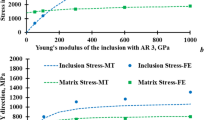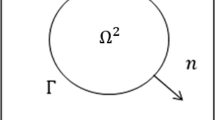Abstract
Quantitative eddy-current nondestructive evaluation is hampered by the lack of suitable models to describe the field/defect interaction. The governing partial differential equations admit of closed-form algebraic solution only in the most trivial of geometries. Finite-element methods hold out the hope of providing numerical solutions for more complex cases. In this paper certain effectively two-dimensional eddy-current problems are considered, previous analytical results being used to validate the computations wherever feasible. The extension to three-dimensional fields, which is outlined here, is treated in detail in a subsequent paper.
Similar content being viewed by others
References
F. Forster and K. Stambke, Theoretische und experimentelle Grundlagen der Werkstoffprufung mit Wirbelstromver fahren,Z. Metallk. 45:166–179 (1954).
A. C. Lynch, A. E. Drake, and C. H. Dix, Measurement of eddy-current conductivity,IEEE Proc. A 130:254–260 (1983).
E. Ball, Thickness and conductivity measurements of sheets of nonferous metals,IEEE Proc. A 134:779–783 (1987).
R. Palanisamy, D. O. Thompson, G. L. Burkhardt, and R. E. Beissner, Eddy current detection of subsurface cracks in engine disk boltholes,Rev. Prog. Quant. NDE 3A:643–652 (1984).
P. Neumaier, Testing steam generator and condenser tubing on site,Br. J. NDT 23:20–26 (1981).
C. N. Owston, Eddy current methods for the detection of carbon fibre reinforced epoxy resins,Mat. Eval. 34:237ff (1976).
M. L. Brown, Calculation of three-dimensional eddy currents at power frequencies,IEEE Proc. A 129:46–53 (1983).
R. J. Lari and L. R. Turner, Survey of eddy current programs,IEEE Trans. Magnet. MAG-19:2474–2477 (1983).
R. Becker, K. Betzold, K. D. Boness, R. Collins, C. C. Holt, and J. Simkin, The modelling of electrical current NDT methods and its application to weld testing,Br. J. NDT 28:361–370 (1986).
L. R. Turner, The FELIX programme of experiments and code development, in C. S. Biddlecombe (ed.), Rutherford Lab Report RL-83-019 (1983).
J. A. M. Davidson and M. J. Balchin, Three-dimensional eddy current calculation using network models,IEEE Trans. Magnet. MAG-19:2325–2328 (1983).
C. R. I. Emson, Electromagnetic workshop, Rutherford Appleton Laboratory Report RAL-86-049 (1986).
M. L. Burrows,A Theory of Eddy Current Flaw Detection, Ph.D. thesis (University of Michigan, Ann Arbor, 1964).
C. V. Dodd and W. E. Deeds, Analytical solutions to eddy current probe coil field problems,J. Appl. Phys. 39:2829–2838 (1968).
J. Bowler, Theory of eddy current probe interaction with subsurface cracks, inElectromagnetic Methods of NDT (Institute of Physics, London, 1985).
B. A. Auld, F. G. Muennemann, and M. Riaziat, Quantitative modelling of flaw responses in eddy current testing, in R. S. Sharpe (ed.),Research Techniques in NDT — 7 (Academic Press, New York, 1984) pp. 37–76.
P. C. French, Eddy currents in a rectangular toroid,IEEE Proc. A 134:309–316 (1987).
A. H. Kahn, R. Spal, and A. Feldman, Eddy current losses due to a surface crack in conducting material,J. Appl. Phys. 48:4454–4459 (1977).
W. Muller and A. Knoblauch, A method for the calculation of three-dimensional eddy currents,IEEE Trans. Magnet. MAG-21:2217–2222 (1985).
C. R. I. Emson, J. Simkin, and C. W. Trowbridge, Further developments of three-dimensional eddy current analysis,IEEE Trans. Magnet. MAG-21:2231–2234 (1985).
P. J. Lawrenson and M. C. Ralph, General three-dimensional solution of eddy current and Laplacian fields in cylindrical structures,Proc. IEEE 117:467–472 (1970).
J. F. Bird, Electromagnetic induction in finite-length cylinders: An exact solution,IEEE Proc. A 134:761–767 (1987).
N. Ida, Development of a three-dimensional eddy current model for NDT phenomena,Rev. Prog. Quant. NDE 3A:547–554 (1984).
W. Lord, Application of numerical field modelling to electromagnetic methods of NDT,IEEE Trans Magnet. MAG-19:2437–2442 (1983).
D. Rodger and A. F. King, Three-dimensional finite-element modelling in eddy current nondestructive testing,IEEE Proc. A 134:301–306 (1987).
R. Palanisamy, R. B. Thompson, and D. O. Thompson, Estimates of eddy current response to subsurface cracks from two-dimensional finite element code predictions,Rev. Prog. Quant. NDE 3A:569–578 (1984).
R. L. Ferrari, Complementary variational formulation for eddy current problems using the field variableE andH directly,IEEE Proc. A 132:157–164 (1985).
P. C. French and L. J. Bond, A three-dimensional finite element model for eddy currents in non-ferrous metals, inMathematical Modeling in NDT, M. Blakemore and G. A. Georgion, eds. (Clarendon Press, Oxford, 1988) pp. 255–277.
D. A. H. Jacobs, The exploitation of sparsity by iterative methods, in I. S. Duff (ed.),Sparse Matrices and Their Uses (Academic Press, New York, 1981).
P. C. French, Submitted for publication.
N. Saffari and L. J. Bond, Body to Rayleigh wave mode-conversion at steps and slots,J. Nondestruct. Eval. 6:1–22 (1987).
D. H. Michael, R. T. Waechter, and R. Collins, The measurement of surface cracks in metals by using AC electric fields,Proc. Roy. Soc. Lond. A381:139–157 (1982).
J. J. Thomson (Lord Kelvin), On the heat produced by eddy currents in an iron plate exposed to an alternating magnetic field,Electrician 28:599–600 (1892).
Author information
Authors and Affiliations
Rights and permissions
About this article
Cite this article
French, P.C., Bond, L.J. Finite-element modeling of eddy-current nondestructive evaluation (NDE). J Nondestruct Eval 7, 55–69 (1988). https://doi.org/10.1007/BF00565777
Received:
Revised:
Issue Date:
DOI: https://doi.org/10.1007/BF00565777




